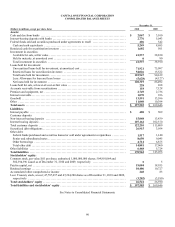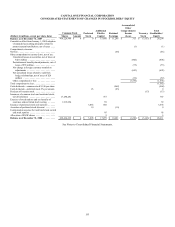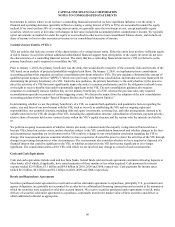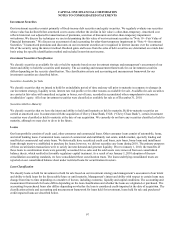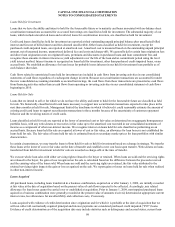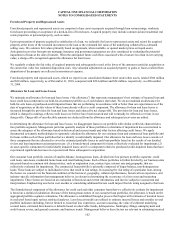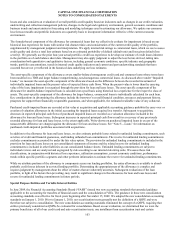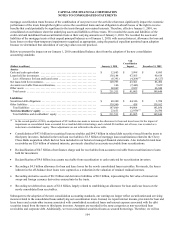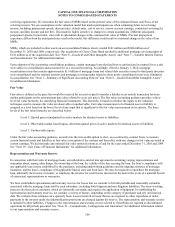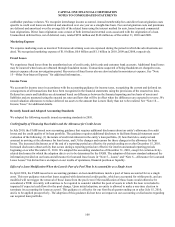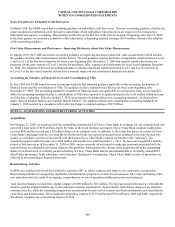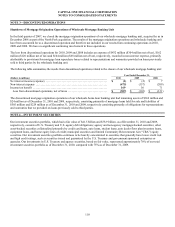Capital One 2010 Annual Report Download - page 120
Download and view the complete annual report
Please find page 120 of the 2010 Capital One annual report below. You can navigate through the pages in the report by either clicking on the pages listed below, or by using the keyword search tool below to find specific information within the annual report.CAPITAL ONE FINANCIAL CORPORATION
NOTES TO CONSOLIDATED STATEMENTS
100
that are 30 are more days past due. Interest and fees continue to accrue on past due loans until the date the loan is placed on
nonaccrual status, if applicable. We generally place loans on nonaccrual status when we believe the collectability of interest and
principal is not reasonably assured.
Nonperforming loans generally include loans that have been placed on nonaccrual status and certain restructured loans whose
contractual terms have been restructured in a manner that grants a concession to a borrower experiencing financial difficulty. We do
not report loans accounted for under the fair value option and loans held for sale as nonperforming.
Our policies for classifying loans as nonperforming, by loan category, are as follows:
• Credit card loans: As permitted by regulatory guidance issued by the Federal Financial Institutions Examination Council
(“FFIEC”), our policy is generally to exempt credit card loans from being classified as nonperforming as these loans are generally
charged off in the period the account becomes 180 days past due. Consistent with industry conventions, we generally continue to
accrue interest and fees on delinquent credit card loans until the loans are charged-off. When we do not expect full payment of
billed finance charges and fees, we reduce the balance of the credit card account by the estimated uncollectible portion of any
billed finance charges and fees and exclude this amount from revenue.
• Consumer loans: We classify other non-credit card consumer loans as nonperforming at the earlier of the date when we determine
that the collectability of interest or principal on the loan is not reasonably assured or in the period in which the loan becomes 90
days past due for automobile and mortgage loans, 180 days past due for unsecured small business revolving lines of credit
and 120 days past due for all other non-credit card consumer loans, including installment loans.
• Commercial loans: We classify commercial loans as nonperforming at the earlier of the date we determine that the collectability
of interest or principal on the loan is not reasonably assured or in the period that the loan becomes 90 days past due.
• Modified loans and troubled debt restructurings: Modified loans, including TDRs, that are current at the time of the restructuring
remain on accrual status if there is demonstrated performance prior to the restructuring and continued performance under the
modified terms is expected. Otherwise, the modified loan is classified as nonperforming and placed on nonaccrual status until the
borrower demonstrates a sustained period of performance over several payment cycles, generally six months of consecutive
payments, under the modified terms of the loan.
• Purchased credit-impaired loans: PCI loans primarily include loans acquired from Chevy Chase Bank, which we recorded at fair
value at acquisition. Because the initial fair value of these loans included an estimate of credit losses expected to be realized over
the remaining lives of the loans, our subsequent accounting for PCI loans differs from the accounting for non-PCI loans. We
therefore separately track and report PCI loans and exclude these loans from our delinquency and nonperforming loan statistics.
Interest and fees accrued but not collected at the date a loan is placed on nonaccrual status are reversed against earnings. In addition,
the amortization of net deferred loan fees is suspended. Interest and fee income is subsequently recognized only upon the receipt of
cash payments. However, if there is doubt regarding the ultimate collectability of loan principal, all cash received is applied against
the principal balance of the loan. Nonaccrual loans are generally returned to accrual status when all principal and interest is current
and repayment of the remaining contractual principal and interest is reasonably assured or when the loan is both well-secured and in
the process of collection and collectability is no longer doubtful.
Impaired Loans
A loan is considered impaired when, based on current information and events, it is probable that we will be unable to collect all
amounts due from the borrower in accordance with the original contractual terms of the loan. Loans with insignificant delays or
insignificant short falls in the amount of payments expected to be collected are not considered to be impaired. Income recognition on
impaired loans is consistent with that of nonaccrual loans discussed above under “Delinquent and Nonperforming Loans.”
Loans defined as individually impaired, based on applicable accounting guidance, include larger balance nonperforming loans and
TDR loans. Our policies for reporting loans as individually impaired, by loan category, are as follows:
• Credit card loans: Credit card loans that have been modified in a troubled debt restructuring are accounted for and reported as
individually impaired.
• Consumer loans: Consumer loans that have been modified in a troubled debt restructuring are accounted for and reported as
individually impaired.


